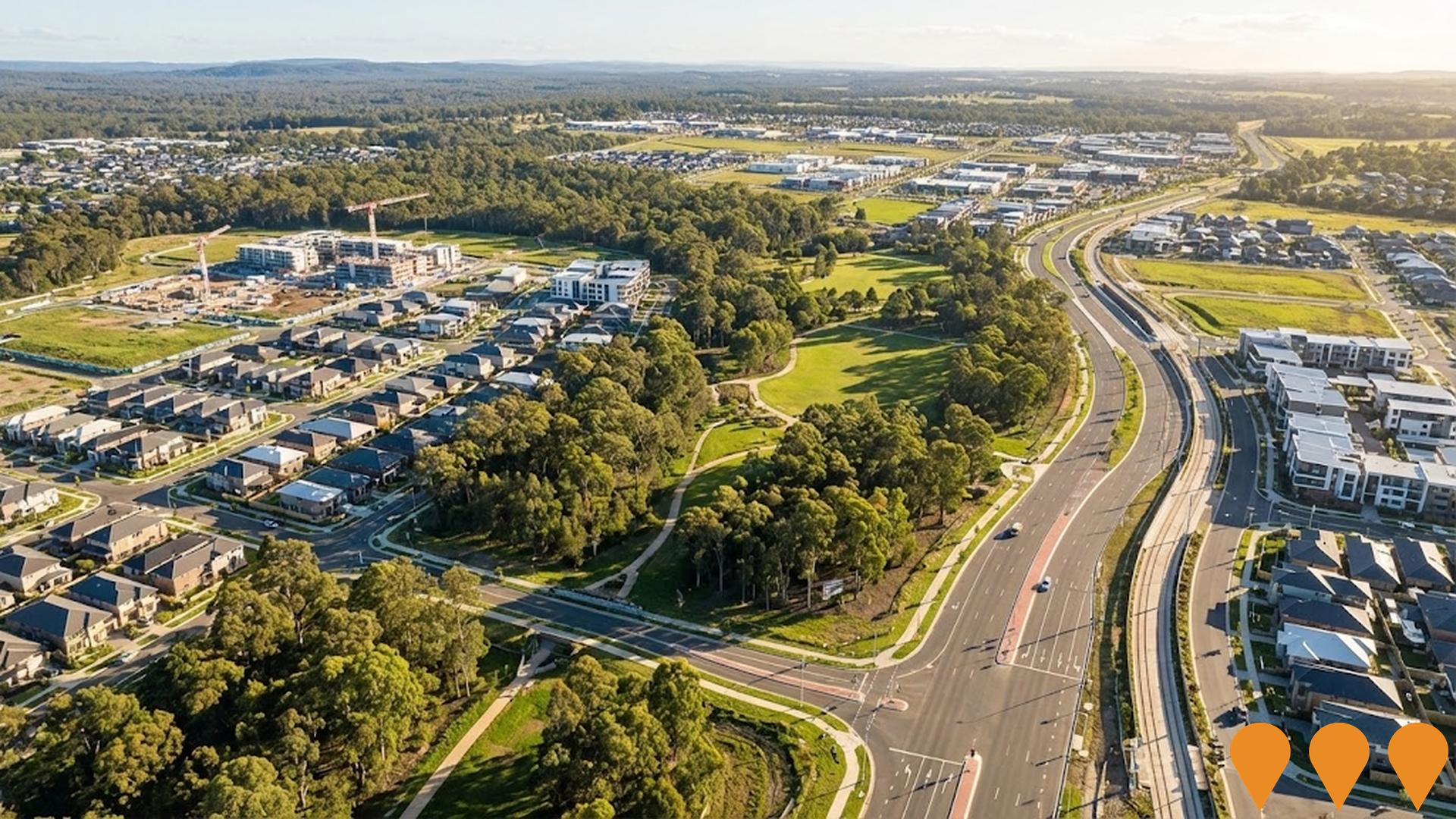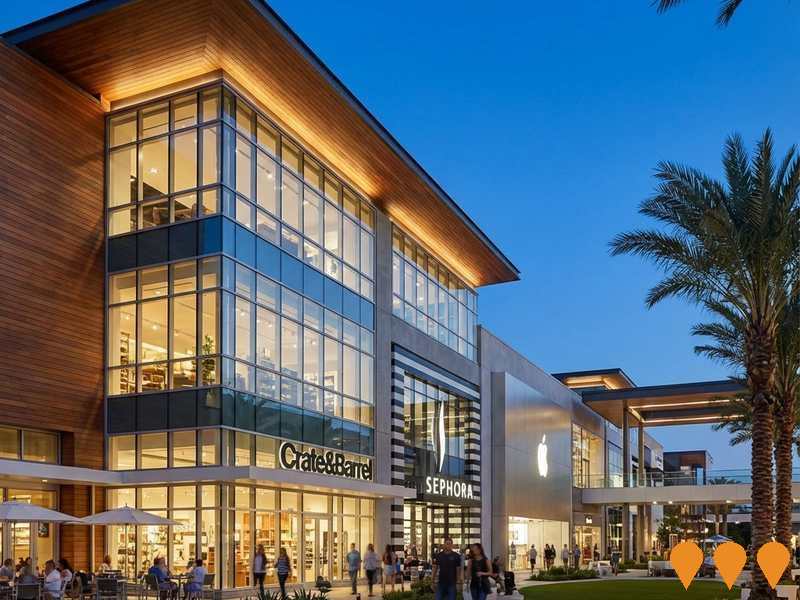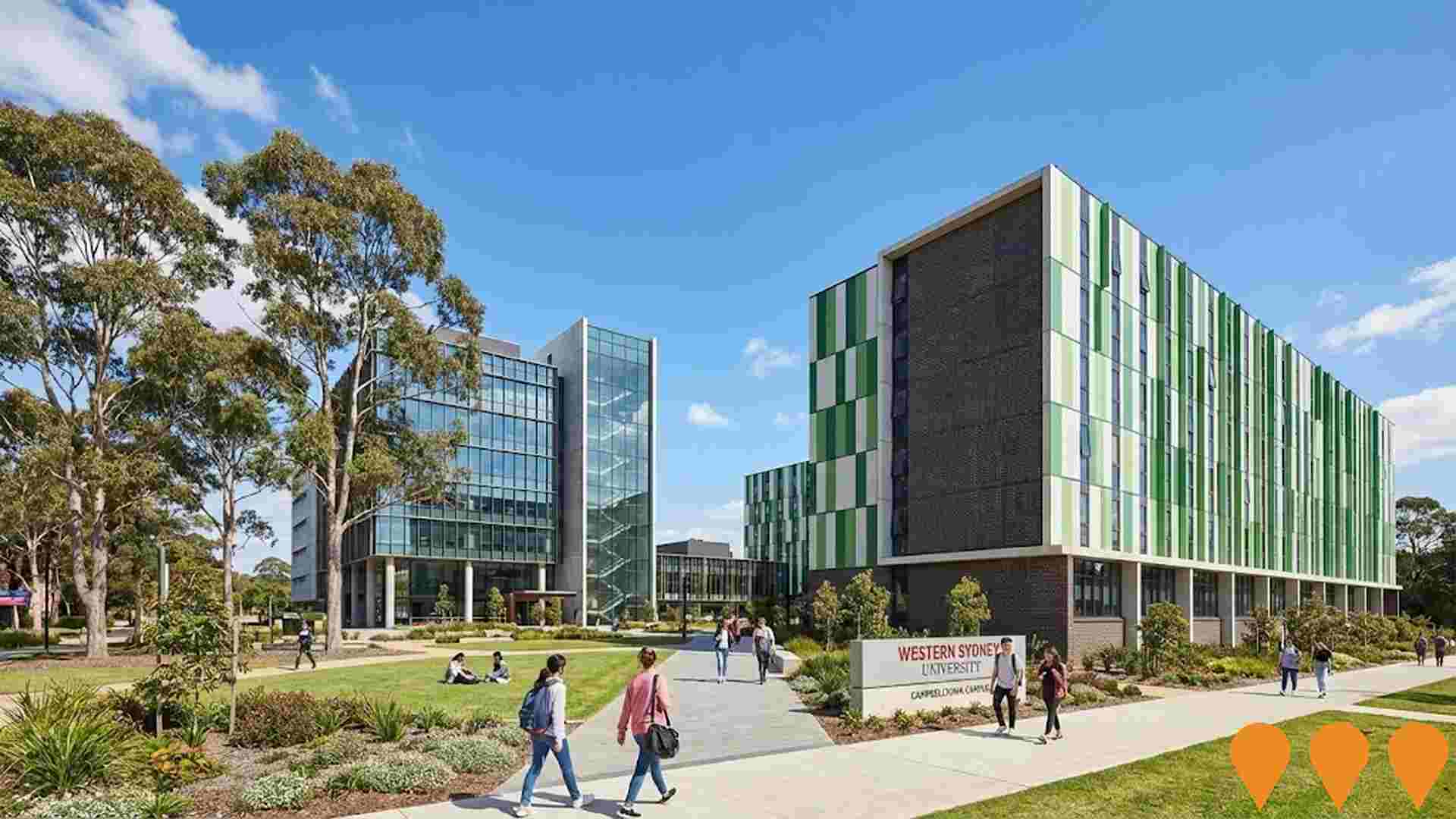Chart Color Schemes
est. as @ -- *
ABS ERP | -- people | --
2021 Census | -- people
Sales Activity
Curious about local property values? Filter the chart to assess the volume and appreciation (including resales) trends and regional comparisons, or scroll to the map below view this information at an individual property level.
Find a Recent Sale
Sales Detail
Population
An assessment of population growth drivers in Bradbury - Wedderburn reveals an overall ranking slightly below national averages considering recent, and medium term trends
Bradbury-Wedderburn's population is 20,739 as of Aug 2025. This shows an increase of 728 people since the 2021 Census, which reported a population of 20,011. The change is inferred from ABS' estimated resident population of 20,705 in June 2024 and additional validated new addresses since the Census date. This results in a density ratio of 565 persons per square kilometer. Bradbury-Wedderburn's growth rate of 3.6% since the census is within 2.8 percentage points of the state's growth rate, indicating competitive fundamentals. Natural growth contributed approximately 58.6% to overall population gains recently.
AreaSearch uses ABS/Geoscience Australia projections for each SA2 area, released in 2024 with a base year of 2022. For areas not covered by this data, NSW State Government's SA2 level projections are used, released in 2022 with a base year of 2021. Growth rates by age group from these aggregations are applied to all areas for years 2032 to 2041. Based on projected demographic shifts, Bradbury-Wedderburn is expected to grow by 1,299 persons to 2041, with an increase of 6.1% in total over the 17-year period.
Frequently Asked Questions - Population
Development
AreaSearch assessment of residential development activity positions Bradbury - Wedderburn among the top 25% of areas assessed nationwide
Bradbury-Wedderburn averaged approximately 153 new dwelling approvals annually over the past five financial years, from FY21 to FY25, totalling 765 homes. As of FY26, 21 approvals have been recorded. Each year, an average of 0.7 new residents per dwelling has been added. This indicates that new supply is meeting or exceeding demand, providing ample buyer choice and allowing for population growth beyond current forecasts.
The average construction value of these dwellings was $364,000, which is below regional norms, reflecting more affordable housing options. In FY26, there have also been $3.4 million in commercial approvals, demonstrating the area's primarily residential nature. Compared to Greater Sydney, Bradbury-Wedderburn has shown somewhat elevated construction activity over the past five years, with 14.0% above the regional average per person.
This preservation of reasonable buyer options sustains existing property demand. Recent construction comprises 79.0% standalone homes and 21.0% medium to high-density housing, maintaining the area's low density nature while attracting space-seeking buyers. With around 114 people per dwelling approval, Bradbury-Wedderburn exhibits characteristics of a low-density area. Looking forward, Bradbury-Wedderburn is projected to grow by 1,261 residents by 2041. At current development rates, new housing supply should comfortably meet demand, creating good conditions for buyers and potentially supporting growth beyond current population projections.
Frequently Asked Questions - Development
Infrastructure
Bradbury - Wedderburn has strong levels of nearby infrastructure activity, ranking in the top 30% nationally
Changes to local infrastructure significantly influence an area's performance. AreaSearch identified 27 projects that could impact the area. Key projects include Airds-Bradbury Renewal Project, Gordon Fetterplace Aquatic Centre Upgrades, Bradbury Multipurpose Courts, and Raith Bradbury Development. The following list details those most likely to be relevant.
Professional plan users can use the search below to filter and access additional projects.
INFRASTRUCTURE SEARCH
 Denotes AI-based impression for illustrative purposes only, not to be taken as definitive under any circumstances. Please follow links and conduct other investigations from the project's source for actual imagery. Developers and project owners wishing us to use original imagery please Contact Us and we will do so.
Denotes AI-based impression for illustrative purposes only, not to be taken as definitive under any circumstances. Please follow links and conduct other investigations from the project's source for actual imagery. Developers and project owners wishing us to use original imagery please Contact Us and we will do so.
Frequently Asked Questions - Infrastructure
Greater Macarthur Growth Area
Strategic growth area incorporating the Glenfield to Macarthur urban renewal precincts and the land release precincts to the south of Campbelltown, including Appin, North Appin and Gilead. Planning for up to 58,000 new dwellings and 40,000 jobs over the next 20 years, with ongoing infrastructure planning and environmental protections.

Newbrook Shopping Village Redevelopment
Neighbourhood shopping centre on a 15,600 sqm E1 Local Centre landholding with value-add potential. A DA has been secured for a childcare facility (max 43 places). Anchored by Friendly Grocer, Chemist Warehouse and Plus Fitness with 13 specialty shops and 112 at-grade car spaces. Offered for sale via EOI by Receivers (EY-Parthenon) with scope for repositioning including a proposed new supermarket, subject to approvals.

Appin (Part) Precinct - Future Appin Communities
Large greenfield precinct in the Greater Macarthur Growth Area on and around Appin Road, planned as three connected Future Appin communities. The 1,378 ha Appin (Part) Precinct was rezoned in December 2023 and is planned to deliver up to 12,900 new homes alongside local centres, schools, parks, sports fields and conservation land. Walker Corporation has lodged a concept and Stage 1 development application for about 9,000 homes, with staging tied to major infrastructure including a $1.9 billion Macarthur Business Park, more than $2 billion in state and local infrastructure, and new water, wastewater and transport upgrades. A draft Precinct Structure Plan and Development Control Plan were exhibited in late 2025 and the Department of Planning is now reviewing submissions; housing construction will begin in stages once final plans and early infrastructure are approved.

Gilead Stage Two
Lendlease's 495ha State Assessed Planning Proposal to transform a site within the Greater Macarthur Growth Area to deliver up to 3,300 new homes, a new school, town centre, and public open space over 10-15 years. The rezoning has been finalised, with 50% of the site (247.8ha) zoned as protected environmental land, including 230ha of mapped koala corridors. The potential development of 3,300 dwellings is approved, with 600 dwelling lots unlocked now, pending adoption of a Precinct Structure Plan and Development Control Plan, and a further 2,700 lots conditional on delivery of necessary infrastructure such as wastewater servicing. Upgrades to Appin Road including koala underpasses are also committed by the proponent.

Western Sydney University Campbelltown Campus Expansion
Ongoing expansion of the Campbelltown Health and Education Precinct, including the Lang Walker AO Medical Research Building, medical school, clinical facilities, student accommodation, and research centres supporting regional healthcare workforce development.

Queen Square Campbelltown
Transformational $400 million mixed-use precinct by ALAND, approved by the Regional Planning Panel. It comprises 558 residential apartments across five buildings (12-15 storeys), over 9,000sqm of retail and commercial space, including an 'Eat Street' dining precinct, and over 4,000sqm of publicly accessible open space with a two-level community building. The development is on the former Brands on Sale outlet site and aims to revitalise the Campbelltown city centre as a new urban neighbourhood and gateway. Construction is planned to commence in 2024.

Airds-Bradbury Renewal Project
Urban renewal of the Airds-Bradbury public housing estate into a mixed community of around 2,100 homes (up to 30% social housing), upgrades to Kevin Wheatley VC Memorial Playing Fields and local open space, seniors housing close to parks and services, and supporting streets and utilities. NSW Government fast-tracked $75m in 2020-21; overall delivery continues in stages toward 2030.

Greater Macarthur Transit Corridor
Future road corridor from Menangle Road, Menangle Park to Appin providing public transport links with potential for light rail, bus rapid transit or metro. Supports growth areas with 46,000 new homes by 2036. The corridor will provide convenient, safe and reliable transport connections throughout the Greater Macarthur Growth Area, prioritizing public transport including dedicated rapid bus lanes. Land protection is currently being implemented through State Environmental Planning Policy (SEPP) mapping.

Employment
The labour market performance in Bradbury - Wedderburn lags significantly behind most other regions nationally
Bradbury-Wedderburn's workforce comprises white and blue-collar employees, with prominent representation in essential services sectors. The unemployment rate was 9.1% as of June 2024, showing a 5.1% increase from the previous year.
As of June 2025, 9,498 residents are employed, but the unemployment rate remains high at 4.9%, above Greater Sydney's rate of 4.2%. Workforce participation lags at 54.4%, compared to Greater Sydney's 60.0%. The dominant employment sectors include health care & social assistance, retail trade, and construction. Notably, transport, postal & warehousing has high concentration with levels at 1.7 times the regional average.
Conversely, professional & technical services show lower representation at 4.1% versus the regional average of 11.5%. Employment opportunities locally appear limited, as indicated by Census data comparing working population to resident population. From June 2024 to June 2025, employment levels increased by 5.1%, and labour force grew by 4.8%, reducing unemployment by 0.3 percentage points. In contrast, Greater Sydney recorded employment growth of 2.6% with a slight increase in unemployment. Jobs and Skills Australia's national employment forecasts from May 2025 project national employment growth at 6.6% over five years and 13.7% over ten years. Applying these projections to Bradbury-Wedderburn's employment mix suggests local growth of approximately 6.2% over five years and 13.2% over ten years, though these are simple extrapolations for illustrative purposes only.
Frequently Asked Questions - Employment
Income
Income levels sit below national averages according to AreaSearch assessment
Bradbury-Wedderburn had a median taxpayer income of $49,627 and an average of $56,958 in the financial year 2022, according to postcode level ATO data aggregated by AreaSearch. This was below the national average, contrasting with Greater Sydney's median income of $56,994 and average income of $80,856. Based on Wage Price Index growth of 12.61% since financial year 2022, current estimates would be approximately $55,885 (median) and $64,140 (average) as of September 2025. Census data from 2021 shows household, family, and personal incomes in Bradbury-Wedderburn ranked modestly, between the 27th and 38th percentiles. Income distribution showed that 34.9% of the population (7,237 individuals) fell within the $1,500 - $2,999 income range, consistent with broader trends across regional levels showing 30.9% in the same category. Housing affordability pressures were severe, with only 79.0% of income remaining, ranking at the 34th percentile.
Frequently Asked Questions - Income
Housing
Bradbury - Wedderburn is characterized by a predominantly suburban housing profile, with a higher proportion of rental properties than the broader region
In Bradbury-Wedderburn, as per the latest Census, 88.3% of dwellings were houses, with the remaining 11.7% comprising semi-detached homes, apartments, and other types. This contrasts with Sydney metropolitan areas, where 78.5% were houses and 21.5% were other dwellings. Home ownership in Bradbury-Wedderburn stood at 21.7%, with mortgaged properties at 39.7% and rented ones at 38.6%. The median monthly mortgage repayment was $2,000, lower than Sydney's average of $2,100. The median weekly rent was $370, compared to Sydney's $380. Nationally, Bradbury-Wedderburn's mortgage repayments were higher than the Australian average of $1,863, while rents were lower than the national figure of $375.
Frequently Asked Questions - Housing
Household Composition
Bradbury - Wedderburn features high concentrations of family households, with a fairly typical median household size
Family households comprise 77.2% of all households, including 35.3% couples with children, 19.8% couples without children, and 20.7% single parent families. Non-family households account for the remaining 22.8%, with lone person households at 20.0% and group households comprising 2.8%. The median household size is 2.9 people, matching the Greater Sydney average.
Frequently Asked Questions - Households
Local Schools & Education
Educational outcomes in Bradbury - Wedderburn fall within the lower quartile nationally, indicating opportunities for improvement in qualification attainment
The area's university qualification rate is 16.0%, significantly lower than Greater Sydney's average of 38.0%. Bachelor degrees are the most common at 10.8%, followed by postgraduate qualifications (3.9%) and graduate diplomas (1.3%). Vocational credentials are prevalent, with 37.3% of residents aged 15+ holding them, including advanced diplomas (10.5%) and certificates (26.8%). Educational participation is high at 32.3%, with 12.4% in primary education, 9.2% in secondary education, and 3.5% pursuing tertiary education.
Eleven schools serve 3,605 students, with typical Australian school conditions (ICSEA: 955) offering balanced educational opportunities. The educational mix includes seven primary, three secondary, and one K-12 school. Note: where schools show 'n/a' for enrolments, please refer to the parent campus.
Frequently Asked Questions - Education
Schools Detail
Nearby Services & Amenities
Transport
Transport servicing is moderate compared to other areas nationally based on assessment of service frequency, route connectivity and accessibility
Transport analysis indicates 149 active public transport stops in Bradbury-Wedderburn area. These are served by 51 bus routes, offering 1,936 weekly passenger trips combined. Residents enjoy excellent transport accessibility, with an average distance of 138 meters to the nearest stop.
Daily service frequency averages 276 trips across all routes, translating to about 12 weekly trips per individual stop.
Frequently Asked Questions - Transport
Transport Stops Detail
Health
Health performance in Bradbury - Wedderburn is lower than average with common health conditions somewhat prevalent across the board, though to a considerably higher degree among older age cohorts
Bradbury - Wedderburn faces significant health challenges with common health conditions prevalent to a higher degree among older age cohorts. Approximately 48% of its total population (~10,016 people) has private health cover, compared to the national average of 55.3%.
The most common medical conditions are arthritis and asthma, affecting 8.9% and 8.9% of residents respectively. Sixty-six point six percent declare themselves completely clear of medical ailments, compared to 70.3% across Greater Sydney. Thirteen point one percent of residents are aged 65 and over (2,727 people), lower than the 14.4% in Greater Sydney. Health outcomes among seniors require more attention than the broader population.
Frequently Asked Questions - Health
Cultural Diversity
Bradbury - Wedderburn was found to be more culturally diverse than the vast majority of local markets in Australia, upon assessment of a range of language and cultural background related metrics
Bradbury-Wedderburn has a higher cultural diversity than most local markets, with 25.1% of its population born overseas and 23.9% speaking a language other than English at home. Christianity is the predominant religion in Bradbury-Wedderburn, accounting for 54.1% of the population. However, Islam is notably overrepresented compared to Greater Sydney, comprising 8.3% versus 12.5%.
The top three ancestry groups are Australian (24.9%), English (22.3%), and Other (13.9%). Samoan (2.4%) and Lebanese (2.0%) are also overrepresented compared to regional averages, while Australian Aboriginal is significantly higher at 5.1% versus the regional average of 3.1%.
Frequently Asked Questions - Diversity
Age
Bradbury - Wedderburn's young demographic places it in the bottom 15% of areas nationwide
Bradbury-Wedderburn has a median age of 33, which is younger than Greater Sydney's figure of 37 and Australia's national average of 38 years. Compared to Greater Sydney, Bradbury-Wedderburn has a higher proportion of residents aged 5-14 (15.7%) but fewer residents aged 25-34 (13.9%). Between the 2021 Census and the present day, the population aged 15-24 has increased from 13.3% to 14.0%, while the proportion of those aged 25-34 has decreased from 14.6% to 13.9%. By 2041, Bradbury-Wedderburn's population is forecast to undergo significant demographic shifts. The 45-54 age group is projected to grow by 16%, adding 391 residents to reach a total of 2,839. Residents aged 65 and older are expected to contribute to 56% of this growth. Meanwhile, the populations in the 25-34 and 0-4 age groups are anticipated to decline.
